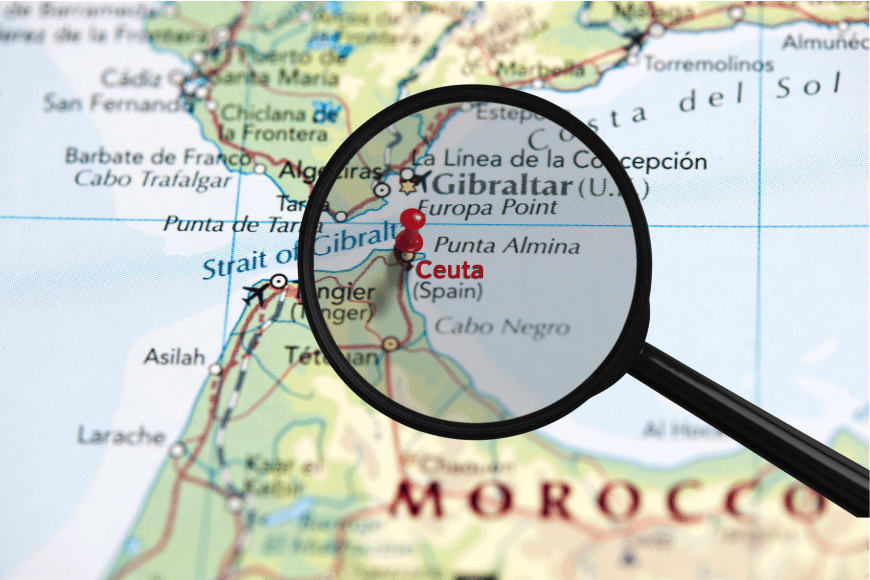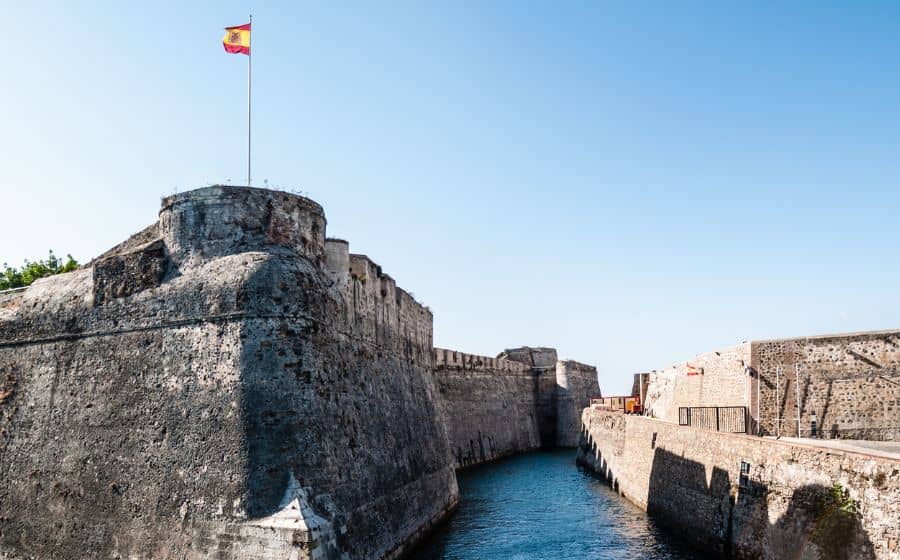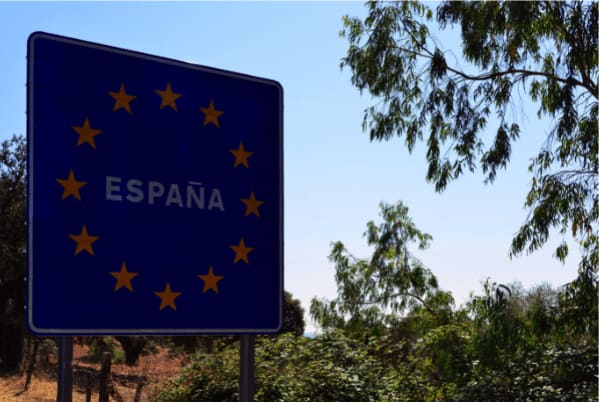Is Spain big? Size and Extension of The 4th Largest European Country
October 4, 2022
Win a FREE Trip to Spain!
Exciting Announcement! For the first time, we're thrilled to offer exclusive trips to the heart of Spain - an experience like no other. This isn't your typical tourist journey; it's a unique opportunity to immerse yourself in authentic Spanish culture, alongside real locals and our passionate team.
But there's more! Simply by requesting information about this amazing trip, you'll be entered into a special draw to win a Fully Paid Trip to Spain for Two. And that's not all - everyone who inquires will receive an exclusive bonus gift, valued at $500, available only now.
Ready to Discover the Real Spain?Click Here ↑ to Request Information & Enter the Draw!
When you think of Spain, how big do you imagine it to be? Now that you have thought about it, which country have you started to compare it with?
Spain is the 4th largest European country BUT if we consider all the nations that occupy a part inside the European territory (even if it’s minimal), it will become the 6th largest country in Europe.
I will show you data about the size and extension of the Spanish territory according to its different Autonomous Communities and its extension within the Iberian Peninsula. And not only that, but I will also compare Spain’s size regarding other European countries and other countries in the world.
I also included an interactive map that will keep you entertained, and I’m sure you will be amazed at what you’ll discover!
If you have searched for information on this subject, but your sources haven’t been the best, don’t worry; you are in the right place. So don’t wait any longer and have a look at this!
Table of Contents ▼ ▶
1. Size and extent of the Spanish territory

Spain is located in the southwest of Europe, occupying 80% of the Iberian Peninsula. Before going into details, you should know that Spain is bordered to the north by the Cantabrian Sea, France, and Andorra and to the east by the Mediterranean Sea. The Mediterranean Sea and the Atlantic Ocean are bordered to the south. And is bordered by the west by the Atlantic Ocean and Portugal. If you want to learn more about Spain and its borders, read the post: Spain Borders: The Neighbors that share our peninsula, oceans, and controversy.
- Extension of the Spanish territory
Regarding its extension, Spain has an area of 505,992 Km2, considering its peninsular size, the Balearic Islands, the Canary Islands, and the Spanish territories located north of Africa.
The territory of peninsular Spain occupies almost the entire Spanish territory, to be exact, 97,56% of the surface. However, it must be taken into account that other territories are Spanish but are not part of the Iberian Peninsula. Here we refer to the Canary and Balearic archipelagos, Ceuta and Melilla, and the Alboran Sea Islands (Alhucemas Islands, Chafarinas Islands, and Peñón de Vélez de la Gomera), located in North Africa.
| SPAIN | Km² | (%) |
|---|---|---|
| Peninsular Spain | 493,653 | 97.561% |
| Canary Islands | 7,237 | 1.430% |
| Balearic Islands | 5,014 | 0.991% |
| Ceuta & Melilla | 32 | 0.006% |
| Alboran Sea Islands | 20 | 0.004% |
| TOTAL SURFACE | 505,992 |
But when we refer to the Iberian Peninsula, 84,54% of the Iberian Peninsula is occupied by peninsular Spain. Most of the remaining percentage corresponds to Portugal (15,29%). But we must also consider the other territories that, although they occupy a small area, are also part of the Iberian Peninsula. These territories are Andorra, which occupies less than 0.1%, the small colonial territory of Gibraltar, and the southernmost part of France, namely the Eastern Pyrenees.
Have a look at this table to better understand:
| IBERIAN PENINSULA | Km² | (%) |
|---|---|---|
| Peninsular Spain | 493,653 | 84.54% |
| Portugal | 89,261 | 15.29% |
| France (Oriental - Pyrenees) | 539 | 0.092% |
| Andorra | 468 | 0.080% |
| Gibraltar | 7 | 0.001% |
| TOTAL SURFACE | 583,928 |
- Extension by autonomous communities
Something important you should know (if you don’t already know it) is that Spain is made up of a total of 17 autonomous communities. And that each one of these communities occupies a determined space in the Spanish territory. Therefore, I thought it could be exciting to make a table where all the communities appear, considering the surface in km2 and the percentage of each inside the Spanish territory.
| Flag | Autonomous Communities | Km² | (%) |
|---|---|---|---|
| 1. Andalusia | 87,599 | 17.31% | |
| 2. Aragon | 47,72 | 9.43% | |
| 3. Basque Country | 7,234 | 1.43% | |
| 4. Canary Islands | 7,447 | 1.47% | |
| 5. Cantabria | 5,321 | 1.05% | |
| 6. Castile and Leon | 94,224 | 18.62% | |
| 7. Castile-La Mancha | 79,461 | 15.70% | |
| 8. Catalonia | 32,113 | 6.35% | |
| 9. Madrid | 8,028 | 1.59% | |
| 10. Valencia | 23,255 | 4.6% | |
| 11. Extremadura | 41,634 | 8.23% | |
| 12. Galicia | 29,575 | 5.84% | |
| 13. Balearic Islands | 4,992 | 0.99% | |
| 14. La Rioja | 5,045 | 1.00% | |
| 15. Navarre | 10,391 | 2.05% | |
| 16. Asturias | 10,604 | 2.13% | |
| 17. Murcia | 11,314 | 2.24% |
2. Spain’s size compared to other European countries
Europe has a total area of 10.5 million km² divided among its 50 countries. The largest country on the European continent is Russia, with a total of 4 million km² of European territory (40% of Europe’s total surface). However, you should know that Russia has a total area of 17.1 million km², but only 25 % is part of European territory. And the smallest country is Vatican City, with 1 km².
In the table I’m going to show you, I will consider all those countries that are part of the European territory, even if some have only a small part. I say this so that you will not be surprised when you see these seven Eurasian countries: Russia, Turkey, Kazakhstan, Azerbaijan, Georgia, Cyprus, and Armenia. These countries will appear with their total surface area.
I’ll give you a brief summary to help you better understand why I have decided to consider these seven countries. Europe and Asia are two different continents, but no natural borders separate them exist, meaning there are no seas or oceans between them. So, as they don’t have natural boundaries that are easily distinguishable, there can be some confusion about which countries are European and which countries are Asian. That’s why some countries have part of their territory on both continents, and then they are considered Eurasian.
Now that you have all the information, here’s a table acoording to Statista with all the countries of Europe by area in square kilometers.
| Countries | Km² |
|---|---|
| 1. Russia | 17,098,242 |
| 2. Kazajistan | 2,725,000 |
| 3. Turkey | 783,500 |
| 4. Ukraine | 603,500 |
| 5. France | 551,695 |
| 6. Spain | 505,992 |
| 7. Sweden | 450,295 |
| 8. Germany | 357,114 |
| 9. Finland | 338,424 |
| 10. Norway | 323,802 |
| 11. Poland | 312,679 |
| 12. Italy | 301,336 |
| 13. United Kingdom | 242,900 |
| 14. Romania | 238,391 |
| 15. Belarus | 207,600 |
| 16. Greece | 131,990 |
| 17. Bulgaria | 110,879 |
| 18. Iceland | 103,000 |
| 19. Hungary | 93,028 |
| 20. Portugal | 92,090 |
| 21. Azerbaiyan | 86,600 |
| 22. Serbia | 88,361 |
| 23. Austria | 83,871 |
| 24. Czech Republic | 78,865 |
| 25. Ireland | 70,273 |
| 26. Georgia | 69,700 |
| 27. Lithuania | 65,300 |
| 28. Latvia | 64,559 |
| 29. Croatia | 56,594 |
| 30. Bosnia and Herzegovina | 51,209 |
| 31. Slovakia | 49,037 |
| 32. Estonia | 45,227 |
| 33. Denmark | 43,094 |
| 34. Netherlands | 41,850 |
| 35. Switzerland | 41,284 |
| 36. Moldova | 33,846 |
| 37. Belgium | 30,528 |
| 38. Armenia | 29,740 |
| 39. Albania | 28,748 |
| 40. Republic of Macedonia | 25,700 |
| 41. Slovenia | 20,273 |
| 42. Montenegro | 13,812 |
| 43. Cyprus | 9,251 |
| 44. Luxembourg | 2,586 |
| 45. Andorra | 468 |
| 46. Malta | 316 |
| 47. Liechtenstein | 160 |
| 48. San Marino | 61 |
| 49. Monaco | 2 |
| 50. Vatican City | 1 |
Spain will be in the 4th position if we don’t consider some Eurasian countries that have a tiny part of their territory in Europe. But as we have considered in this table all the countries, it would be in 6th place.
3. How big is Spain compared to the world?
It’s tough to get an idea of the size of Spain compared to the rest of the world.
That’s why I thought the easiest way to see its size and have an idea of how big Spain is, compared to other countries, was through an interactive map. It will be fun, and I think you will get more than one surprise.
So let’s play a little game!
How big is the United States compared to Europe? How big is New York compared to France? I encourage you to enter the names of the countries or states in this interactive map and drag them around to compare them by superimposing one on top of another. Here’s the link: https://www.thetruesize.com/.
You should know this map uses the Mercator projection (a standard for many maps on the Web), so you will notice how the size of the countries changes as you drag them towards the Equator or the poles.
For a better understanding, in the Mercator projection, the elements near the poles are larger than their actual size, while the elements near the Equator are smaller than their real dimension.
There’s also another projection known as the Gall-Peters projection that represents elements of the Earth’s surface proportionally to their actual size in space. It’s just an interesting fact to add, but we won’t take it into account for this.
In addition to this, I thought it would be very interesting to add these images where we can see a clear comparison of the size of Spain to other countries.
Spain compared to European countries:
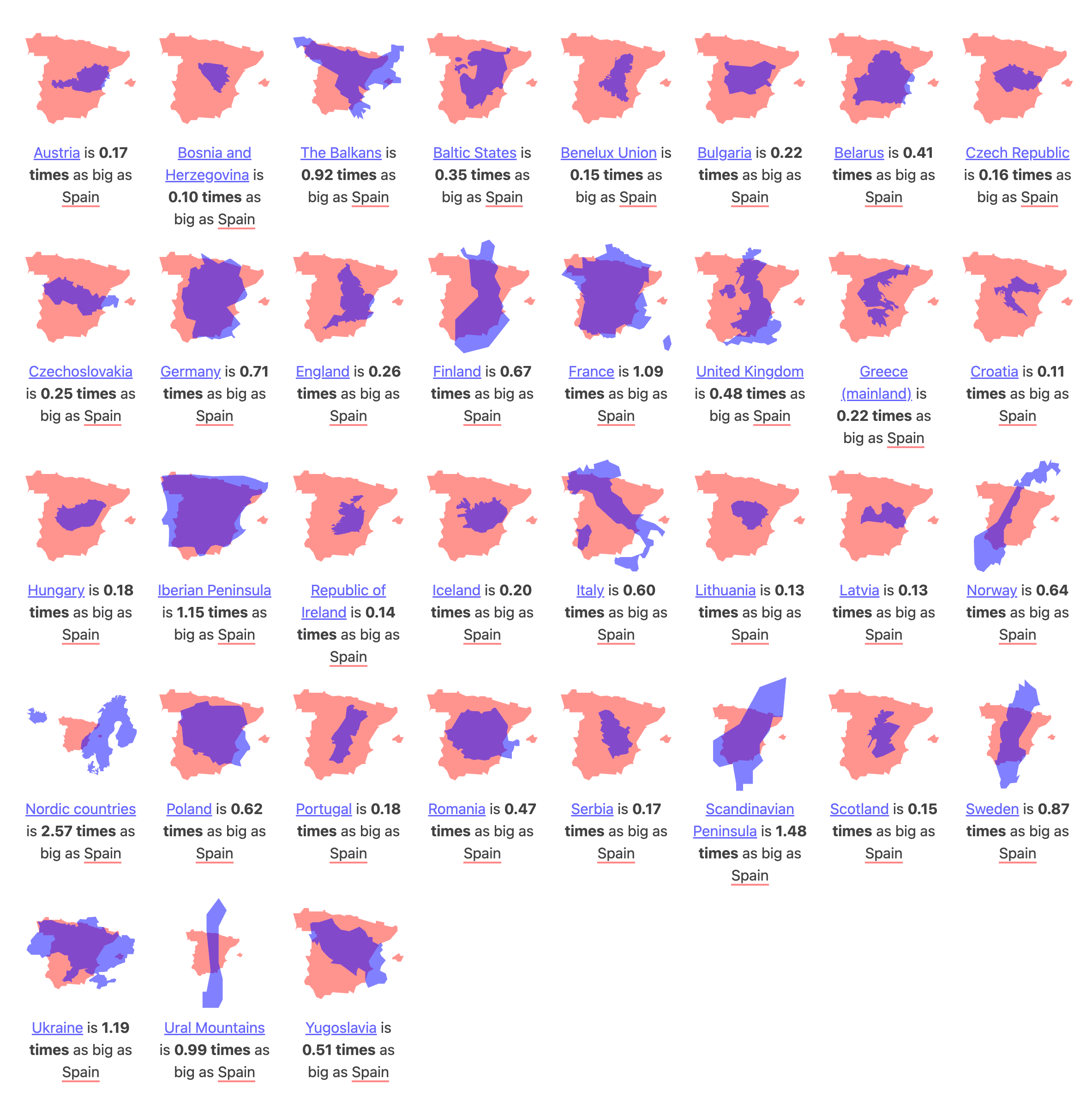
Spain compared to American countries:

Spain compared to US States:
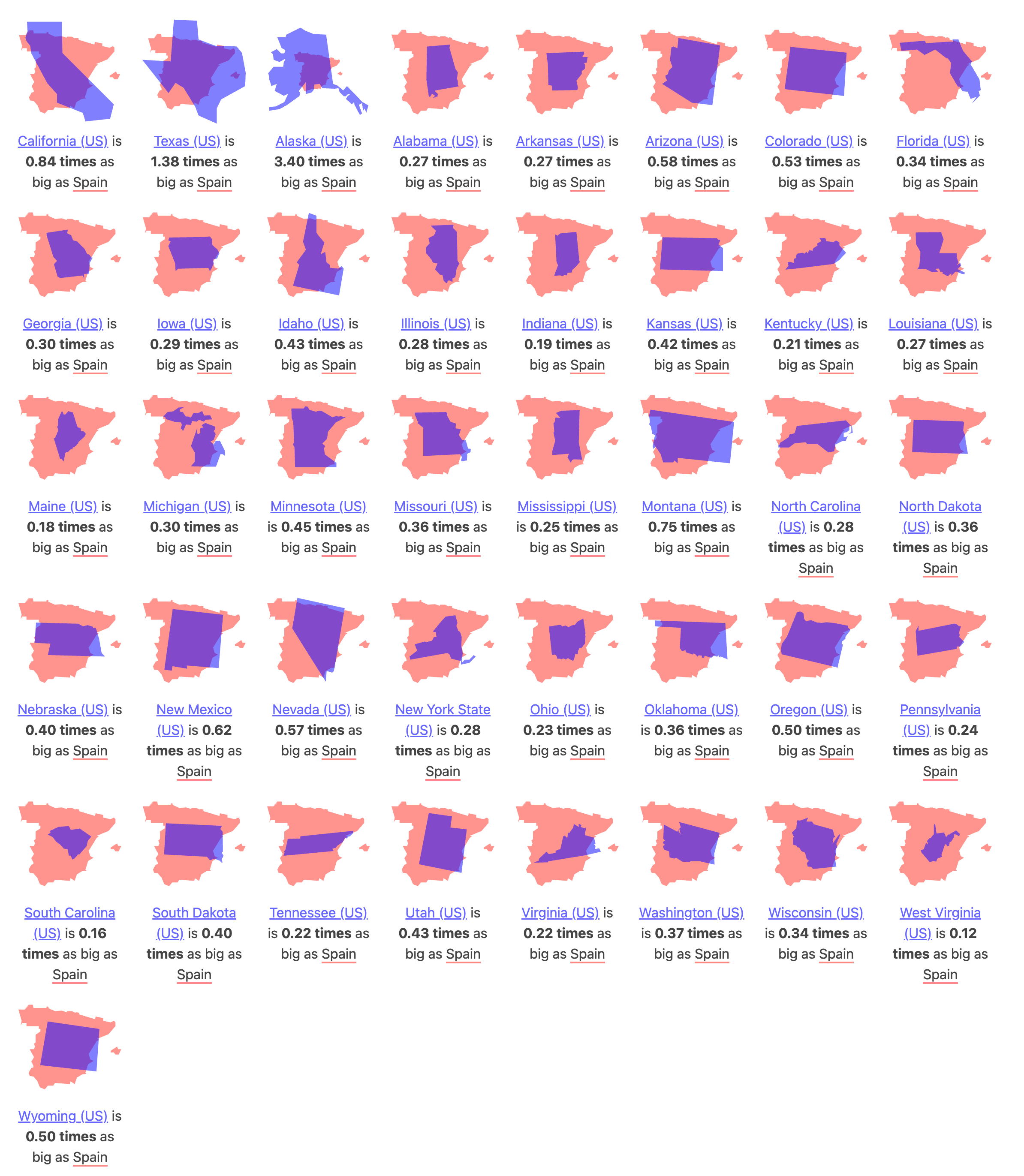
Spain compared to African countries:

Spain compared to Asian countries:
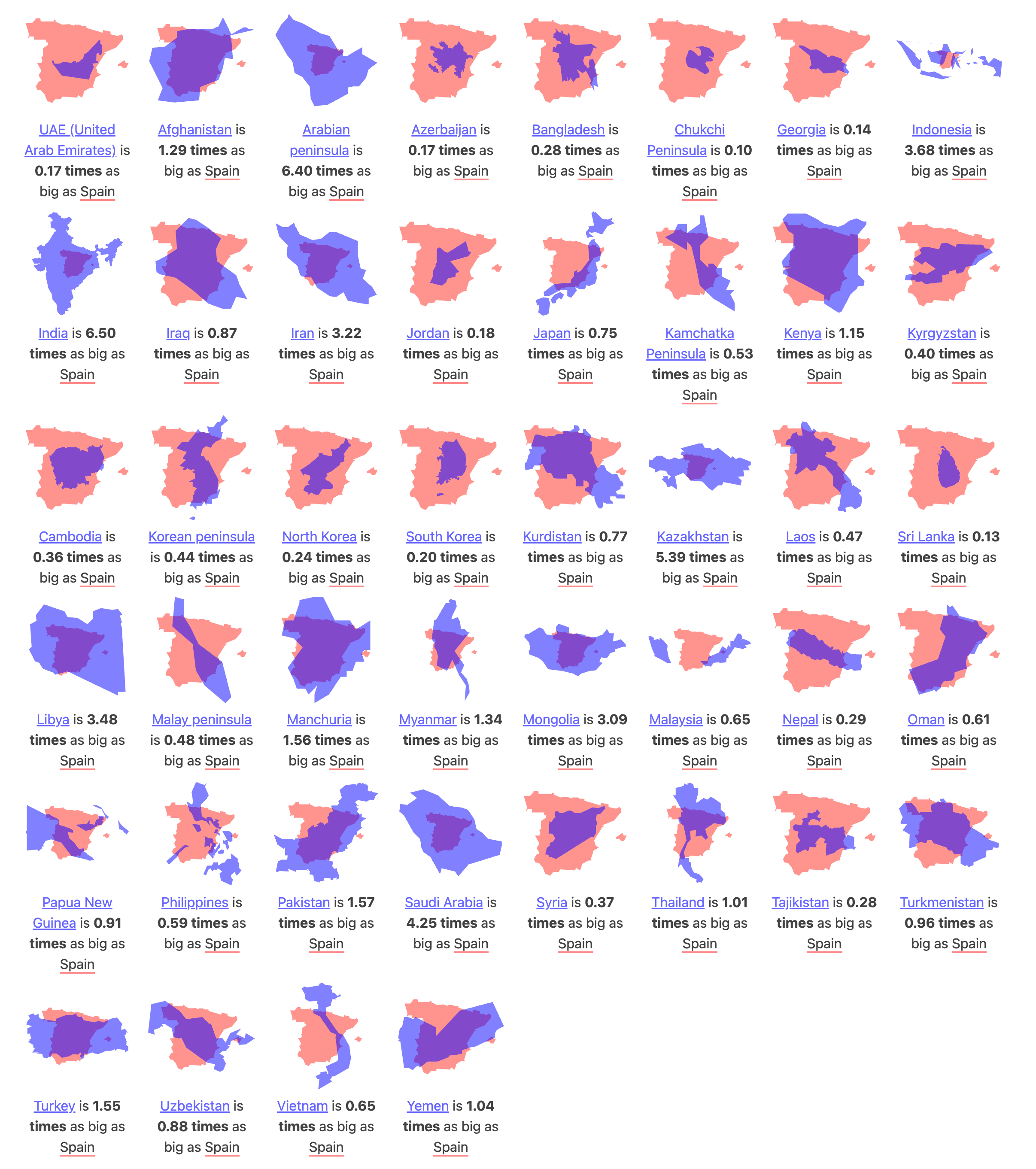
When you read the title of this post, did you imagine it like this?
I’ve spent a lot of time searching for the correct information to write this post, so all the data reflected are reliable.
After reading this post, I hope you have a better projection of how big Spain is. And I also hope we become one of your favorite sources when looking for anything related to Spain!



